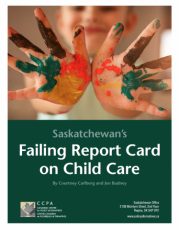
Saskatchewan's Failing Report Card on Child Care
The Canadian Centre for Policy Alternatives has released a report identifying Saskatchewan as the province with the lowest ranking for overall quality and rates of access to regulated child care. This report was co-authored by Courtney Carlberg, research coordinator in the University of Saskatchewan College of Nursing and Treasurer for the Spadina Early Learning and Childcare Co-operative in Saskatoon, and Jen Budney, recent JSGS doctoral graduate, postdoctoral fellow at the Centre for the Study of Co-operatives, and Chair of the Board of the Spadina Early Learning and Childcare Co-operative.
By Canadian Centre for Policy Alternatives
Regina — Canada ranks very poorly among peer nations for overall quality measures and rates of access to regulated child care, and Saskatchewan ranks the lowest of all Canadian provinces. A new report from CCPA-Saskatchewan explores the piecemeal way in which child care policy has been developed by successive governments of all political stripes since 1969, and offers several recommendations for how to improve child care services that are of vital interest to the public.
Saskatchewan’s Failing Report Card on Child Care, by Courtney Carlberg and Jen Budney, reviews the consequences of the province’s historic neglect of child care and asks why successive governments have been so reluctant to invest in affordable, flexible, high-quality care programs for their youngest constituents. The authors demonstrate that while all families struggle under the current child care system, those most negatively affected include families living in rural and remote areas; Indigenous families; single parents; parents doing shift, contract or seasonal work; and low income families generally.
Among the report's highlights:
- Saskatchewan’s child care policy continues to be based on outdated and inaccurate family models in which one parent (the father) goes to work and the other (the mother) stays at home.
- Licensed child care in Saskatchewan can accommodate only 18% of children aged 5 and under, but 70% of Saskatchewan mothers of children aged 5 and under go to work.
- Household income levels eligible for a child care subsidy were frozen in the 1980s. This means that many families today—even many living below the poverty line—are too “rich” for assistance and too poor to pay for licensed child care.
- The income cut-off for the maximum subsidy (covering 90% of fees) for a two-parent family with two children is $1,740/month or $20,880 (gross) per year, which has not been increased since the 1980s. If this income threshold were adjusted for inflation, families earning less than $49,248 today would be eligible for full subsidies.
- The government’s current Early Years Plan 2016-2020 contains no concrete plans or policies, no clear targets for the development of child care spaces, no guaranteed budgets and no measures of evaluation.
The authors conclude by making several policy recommendations for improving child care in Saskatchewan, including appropriate funding, overhauling the current subsidy system, mandatory wages for early childhood educators and early childhood assistants, and moving responsibility for all child care and early learning policies to a single ministry.
Saskatchewan's Failing Report Card on Child Care is available on the CCPA website.
For more information and interviews contact the authors:
Courtney Carlberg (306) 227-8134
Jen Budney (306) 850-0286

